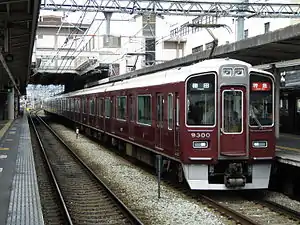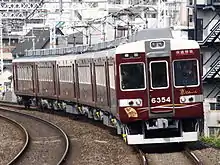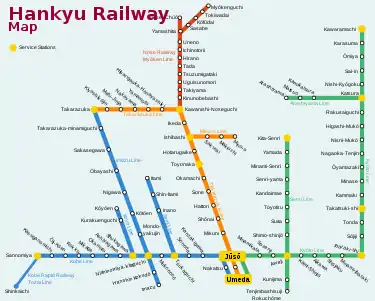Hankyu Kyoto Main Line
The Hankyu Kyoto Main Line (阪急京都本線, Hankyū Kyōto Honsen) is a railway line in Japan operated by the private railway operator Hankyu Railway. It connects Osaka-umeda Station in Osaka and Kyoto-kawaramachi Station in Kyoto.
| Hankyu Kyoto Main Line | |||
|---|---|---|---|
 A 9300 series EMU on a limited express service | |||
| Overview | |||
| Native name | 阪急京都本線 | ||
| Locale | Kansai | ||
| Termini | Jūsō Kyoto-kawaramachi | ||
| Stations | 26 | ||
| Service | |||
| Operator(s) | Hankyu Railway | ||
| Depot(s) | Shōjaku Katsura | ||
| Technical | |||
| Line length | 45.3 km (28.1 mi) | ||
| Number of tracks | Double | ||
| Track gauge | 1,435 mm (4 ft 8 1⁄2 in) | ||
| Electrification | 1,500 V DC, overhead line | ||
| Operating speed | 115 km/h (70 mph) | ||
| |||
| Hankyu Kyoto Main Line | ||||||||||||||||||||||||||||||||||||||||||||||||||||||||||||||||||||||||||||||||||||||||||||||||||||||||||||||||||||||||||||||||||||||||||||||||||||||||||||||||||||||||||||||||||||||||||||||||||||||||||||||||||||||||||||||||||||||||||||||||||||||||||||||||||||||||||||||||||||||||||||||||||||||||||||||||||||||||||||||||||||||||||||||||||||||||||||||||||||||||||||||||||||||||||||||||||||||||||||||||||||||||||||||||||||||||||||||||||||||||||||||||||||||||||||||||||||||||||||||||||||||||||||||||||||||||||||||||||||||||||||||||||||||||||||||||||||||||||||||||||||||||||||||||||||||||||||||||||||||||||||||||||||||||||||||||||||||||||||||||||||||||||||||||||||||||||||||||||||||||||||||||||||||||
|---|---|---|---|---|---|---|---|---|---|---|---|---|---|---|---|---|---|---|---|---|---|---|---|---|---|---|---|---|---|---|---|---|---|---|---|---|---|---|---|---|---|---|---|---|---|---|---|---|---|---|---|---|---|---|---|---|---|---|---|---|---|---|---|---|---|---|---|---|---|---|---|---|---|---|---|---|---|---|---|---|---|---|---|---|---|---|---|---|---|---|---|---|---|---|---|---|---|---|---|---|---|---|---|---|---|---|---|---|---|---|---|---|---|---|---|---|---|---|---|---|---|---|---|---|---|---|---|---|---|---|---|---|---|---|---|---|---|---|---|---|---|---|---|---|---|---|---|---|---|---|---|---|---|---|---|---|---|---|---|---|---|---|---|---|---|---|---|---|---|---|---|---|---|---|---|---|---|---|---|---|---|---|---|---|---|---|---|---|---|---|---|---|---|---|---|---|---|---|---|---|---|---|---|---|---|---|---|---|---|---|---|---|---|---|---|---|---|---|---|---|---|---|---|---|---|---|---|---|---|---|---|---|---|---|---|---|---|---|---|---|---|---|---|---|---|---|---|---|---|---|---|---|---|---|---|---|---|---|---|---|---|---|---|---|---|---|---|---|---|---|---|---|---|---|---|---|---|---|---|---|---|---|---|---|---|---|---|---|---|---|---|---|---|---|---|---|---|---|---|---|---|---|---|---|---|---|---|---|---|---|---|---|---|---|---|---|---|---|---|---|---|---|---|---|---|---|---|---|---|---|---|---|---|---|---|---|---|---|---|---|---|---|---|---|---|---|---|---|---|---|---|---|---|---|---|---|---|---|---|---|---|---|---|---|---|---|---|---|---|---|---|---|---|---|---|---|---|---|---|---|---|---|---|---|---|---|---|---|---|---|---|---|---|---|---|---|---|---|---|---|---|---|---|---|---|---|---|---|---|---|---|---|---|---|---|---|---|---|---|---|---|---|---|---|---|---|---|---|---|---|---|---|---|---|---|---|---|---|---|---|---|---|---|---|---|---|---|---|---|---|---|---|---|---|---|---|---|---|---|---|---|---|---|---|---|---|---|---|---|---|---|---|---|---|---|---|---|---|---|---|---|---|---|---|---|---|---|---|---|---|---|---|---|---|---|---|---|---|---|---|---|---|---|---|---|---|---|---|---|---|---|---|---|---|---|---|---|---|---|---|---|---|---|---|---|---|---|---|---|---|---|---|---|---|---|---|---|---|---|---|---|---|---|---|---|---|---|---|---|---|---|---|---|---|---|---|---|---|---|---|---|---|---|---|---|---|---|---|---|---|---|---|---|---|---|---|---|---|---|---|---|---|---|---|---|---|---|---|---|---|---|---|---|---|---|---|---|---|---|---|---|---|---|---|---|---|---|---|---|---|---|---|---|---|---|---|---|---|---|---|---|---|---|---|---|---|---|---|---|---|---|---|---|---|---|---|---|---|---|---|---|---|---|---|---|---|---|---|---|---|---|---|---|---|---|---|---|---|---|---|---|---|---|---|---|---|---|---|---|---|---|---|---|---|---|---|---|---|---|---|---|---|---|---|---|---|---|---|---|---|---|---|---|---|---|---|
| ||||||||||||||||||||||||||||||||||||||||||||||||||||||||||||||||||||||||||||||||||||||||||||||||||||||||||||||||||||||||||||||||||||||||||||||||||||||||||||||||||||||||||||||||||||||||||||||||||||||||||||||||||||||||||||||||||||||||||||||||||||||||||||||||||||||||||||||||||||||||||||||||||||||||||||||||||||||||||||||||||||||||||||||||||||||||||||||||||||||||||||||||||||||||||||||||||||||||||||||||||||||||||||||||||||||||||||||||||||||||||||||||||||||||||||||||||||||||||||||||||||||||||||||||||||||||||||||||||||||||||||||||||||||||||||||||||||||||||||||||||||||||||||||||||||||||||||||||||||||||||||||||||||||||||||||||||||||||||||||||||||||||||||||||||||||||||||||||||||||||||||||||||||||||
Definition
The Kyoto Main Line is often called the Kyoto Line (京都線, Kyōto-sen) for short, and in a broader sense its two branch lines, the Senri Line and the Arashiyama Line, are included to the Kyoto Line by historical, geographical and structural reasons. The other two sections of Hankyu, the Kobe Line and the Takarazuka Line are called the Shinpōsen (神宝線) as a whole.
Officially, the Kyoto Main Line is from Jūsō to Kyoto-kawaramachi, however, all trains run beyond Jūsō to Osaka-umeda terminal, using the eastern tracks of the section exclusively. Hankyu treats the Kyoto Main Line in the same way as the passengers do, i.e. as the line between Osaka-umeda and Kyoto-kawaramachi (except for special circumstances such as governmental procedures).
History
The Kyoto Main Line was constructed in the following phases:[1]
- April 1, 1921: Jūsō – Awaji (by Kita-Osaka Electric Railway)
- January 16, 1928: Awaji – Takatsuki-machi (present-day Takatsuki-shi) (by Shin-Keihan Railway)
- November 1, 1928: Takatsuki-machi – Kyoto-Saiin (present-day Saiin) (by Shin-Keihan Railway)
- March 31, 1931: Saiin – Keihan-Kyoto (present-day Ōmiya) (by Keihan Electric Railway)
- February 18, 1959: The additional double tracks of the Takarazuka Main Line between Umeda (present-day Osaka-umeda) and Jūso now used exclusively by the Kyoto Main Line
- June 17, 1963: Ōmiya – Kawaramachi (now Kyoto-kawaramachi)
Prior to the merger of Hankyu Railway (then Hanshin Kyūkō Railway) and Keihan Electric Railway in 1943, the line and its branches were owned by the latter and called the Shin-Keihan (New Keihan) Line. In the breakup of the merger in 1949, the line was not ceded to Keihan and became a competitor of the Keihan Main Line.[1]
Proposed connecting line
A loop line from Juso to Awaji via Shin-Osaka station, to provide a direct connection to the Shinkansen has been proposed, but is not currently scheduled for construction.
Service types
Regular operations
In the timetable revised on December 21, 2013,[2] regular trains are classified as follows:
Local (普通, futsū)
- Through service: All-stations "Local" trains operate between Osaka-umeda and Kita-Senri (on the Senri Line, connected at Awaji) and between Takatsuki-shi and Tengachaya (on the Osaka Metro Sakaisuji Line, via the Senri Line).
Semi-Express (準急, junkyū)
Sakaisuji Semi-Express (堺筋準急, sakaisuji junkyū)
- Operated on weekday rush hours, Saturdays and holidays
- Through service: Sakaisuji Semi-Express trains operate between Kyoto-kawaramachi or Takatsuki-shi and Tengachaya.
Rapid (快速, kaisoku)
- Rush hours only.
- Officially referred to as Rapid Service in English.
Rapid Express (快速急行, kaisoku kyūkō)
- Rush hours only.
Limited Express (特急, tokkyū)
- Operated on off-peak hours.
Commuter Limited Express (通勤特急, tsūkin tokkyū)
- Weekdays rush hours only.
Rapid Limited Express (快速特急, kaisoku tokkyū) & Rapid Limited Express A (快速特急A, kaisoku tokkyū A)
- Weekends only, collectively known as the Kyotrain (京とれいん, Kyōtorein)
Extra services
- Rapid Limited Express (快速特急, kaisoku tokkyū)
- Osaka-umeda - Arashiyama: "Sagano (さがの, named after the district in Ukyo-ku, Kyoto)"
- Kyoto-kawaramachi - Arashiyama: "Ogura (おぐら, named after Mount Ogura)"
- Direct Limited Express (直通特急, chokutsū tokkyū) - Through services to Arashiyama Line, Osaka Metro Sakaisuji Line, Takarazuka Main Line and the Kobe Main Line.
- Kosoku Kobe - Arashiyama: "Atago (あたご, named after Mount Atago)"
- Takarazuka - Arashiyama (via the Imazu Line): "Togetsu (とげつ, named after Togetsukyo Bridge)"
- Tengachaya - Arashiyama: "Hozu (ほづ, named after the Hozu River)" (seasonal service)
- On the Kyoto Main Line, these extra limited express stop at the same stations as the regular Rapid Limited Express.
Stations
Legends:
- ● : Trains stop.
- | : Trains pass.
Local trains stop at all stations.
No trains stop at Nakatsu which is served by Local trains on the Kobe Main Line and the Takarazuka Main Line, because of the absence of any platforms on this line. Thus, in operation, Nakatsu Station is not listed on the Kyoto Line.
The starting point of the distances (km) shown is Jūsō Station, which is officially the starting point of the Kyoto Main Line.
| Line name | No. | Station | Distance (km) | Semi-Express | Sakaisuji Semi-Exp. | Rapid | Rapid Exp. | Commuter Ltd. Exp. | Ltd. Exp. | Rapid Ltd. Exp. | Rapid Ltd. Exp. A | Transfers | Location | ||
|---|---|---|---|---|---|---|---|---|---|---|---|---|---|---|---|
| Through services: | From Awaji:
Local / Sakaisuji Semi-Express ー From Kawaramachi to Tengachaya via the Local — From Osaka-umeda to Kita-Senri via the | ||||||||||||||
| Takarazuka Main Line | HK-01 | Osaka-umeda | 大阪梅田 | (2.4) | ● | ● | ● | ● | ● | ● | ● |
|
Kita-ku, Osaka | Osaka Prefecture | |
| HK-03 | Jūsō | 十三 | 0.0 | ● | ● | ● | ● | ● | ● | | | Yodogawa-ku, Osaka | ||||
| Kyoto Main Line | |||||||||||||||
| HK-61 | Minamikata | 南方 | 1.9 | ● | ● | | | | | | | | | | | |||||
| HK-62 | Sōzenji | 崇禅寺 | 3.2 | | | | | | | | | | | | | | | Higashiyodogawa-ku, Osaka | ||||
| HK-63 | Awaji | 淡路 | 4.2 | ● | ● | ● | ● | | | ● | ● | ● |
| |||
| HK-64 | Kami-Shinjō | 上新庄 | 6.3 | ● | ● | ● | | | | | | | | | | | ||||
| HK-65 | Aikawa | 相川 | 7.2 | | | | | | | | | | | | | | | | | ||||
| HK-66 | Shōjaku | 正雀 | 9.4 | | | | | | | | | | | | | | | | | Settsu | |||
| HK-67 | Settsu-shi | 摂津市 | 10.9 | | | | | | | | | | | | | | | | | ||||
| HK-68 | Minami-Ibaraki | 南茨木 | 12.9 | ● | ● | ● | | | | | | | | | | | ■ Osaka Monorail Main Line (19) | Ibaraki | ||
| HK-69 | Ibaraki-shi | 茨木市 | 14.8 | ● | ● | ● | ● | ● | ● | | | | | ||||
| HK-70 | Sōjiji | 総持寺 | 16.8 | | | | | | | | | | | | | | | | | ||||
| HK-71 | Tonda | 富田 | 17.3 | | | | | | | | | | | | | | | | | Takatsuki | |||
| HK-72 | Takatsuki-shi | 高槻市 | 20.6 | ● | ● | ● | ● | ● | ● | | | | | ||||
| HK-73 | Kammaki | 上牧 | 24.9 | ● | ● | | | | | | | | | | | | | ||||
| HK-74 | Minase | 水無瀬 | 25.7 | ● | ● | | | | | | | | | | | | | Shimamoto | |||
| HK-75 | Ōyamazaki | 大山崎 | 27.7 | ● | ● | | | | | | | | | | | | | Ōyamazaki | Kyoto Prefecture | ||
| HK-76 | Nishiyama Tennozan[2][3] | 西山天王山 | 30.2 | ● | ● | | | | | | | | | | | | | Nagaokakyō | |||
| HK-77 | Nagaoka-Tenjin | 長岡天神 | 31.7 | ● | ● | ● | ● | ● | ● | | | | | ||||
| HK-78 | Nishi-Mukō | 西向日 | 33.6 | ● | ● | | | | | | | | | | | | | Mukō | |||
| HK-79 | Higashi-Mukō | 東向日 | 35.0 | ● | ● | | | | | | | | | | | | | ||||
| HK-80 | Rakusaiguchi | 洛西口 | 36.3 | ● | ● | | | | | | | | | | | | | Nishikyō-ku, Kyoto | |||
| HK-81 | Katsura | 桂 | 38.0 | ● | ● | ● | ● | ● | ● | ● | ● | ||||
| HK-82 | Nishi-Kyōgoku | 西京極 (西京極総合運動公園前) |
40.1 | ● | ● | | | | | | | | | | | | | Ukyō-ku, Kyoto | |||
| HK-83 | Saiin | 西院 | 41.9 | ● | ● | ● | ● | ● | | | | | | | ||||
| HK-84 | Ōmiya | 大宮 | 43.3 | ● | ● | ● | ● | ● | | | | | | | Nakagyō-ku, Kyoto | |||
| HK-85 | Karasuma | 烏丸 | 44.4 | ● | ● | ● | ● | ● | ● | ● | ● | Shimogyō-ku, Kyoto | |||
| HK-86 | Kyoto-kawaramachi | 京都河原町 | 45.3 | ● | ● | ● | ● | ● | ● | ● | ● | ||||
Rolling stock

- 1300 series EMU (from 30 March 2014)
- 3300 series EMU
- 5300 series EMU
- 6300 series EMU (Kyō-Train)
- 7000 series EMU (Kyō-Train Garaku)
- 7300 series EMU
- 8300 series EMU
- 9300 series EMU
- Osaka Municipal Subway 66 series EMU (Awaji - Takatsuki-shi)
Former
- 1300 series EMU (1957)
- 2000 series EMU (Temporary)
- 2300 series EMU
- 2800 series EMU
- 5100 series EMU (Temporary)
- Osaka Municipal Subway 60 series EMU (Awaji - Takatsuki-shi)
References
This article incorporates material from the corresponding article in the Japanese Wikipedia
- Hankyu Corporation & Morokawa, Hisashi (1990). 日本の私鉄7 阪急 (in Japanese). Hoikusha. p. 147. ISBN 4-586-50796-9.
- Hankyu Corporation (September 20, 2013). "西山天王山駅の開業にあわせて 京都線のダイヤ改正を実施します" [We will revise the schedule of the Kyoto Line in line with the opening of Nishiyama Tennoyama Station] (PDF) (Press release) (in Japanese).
- City of Nagaokakyō; Hankyu Corporation (March 30, 2012). "阪急京都本線大山崎駅~長岡天神駅間で建設中の新駅の名称を『西山天王山』駅に決定しました" [The name of the new station under construction between Oyamazaki Station and Nagaoka Tenjin Station on the Hankyu Kyoto Main Line has been decided as "Nishiyama Tennoyama" Station.] (PDF) (Press release) (in Japanese).
